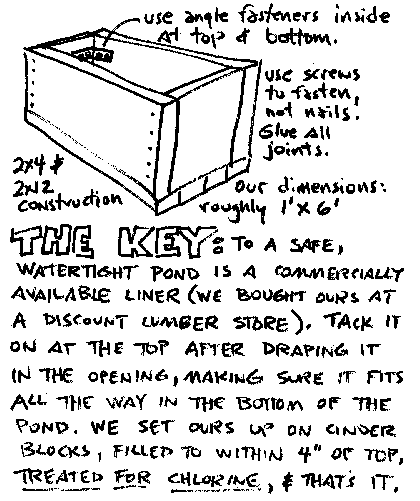
OK, what are your options? Can it be done cheaper and quicker? Yes. I have seen ponds at lawn and garden shops made simply by laying cinder blocks on the floor to shape the pond, then draping the liner over them and capping the top with a row of rock (which would be optional.) The goal is finding some way to shape the pond and contain the water safely.
A way to cut costs with the liner is to call a few swimming pool companies and ask if they have old swimming pool liners to give away. While not as heavy as commercial pond liners, I think by using two layers they are just as safe. We built a pond in our back yard with one and direct sunlight tends to break it down, but indoors you should have nothing to worry about.
You will find, of course, you still need fish, and the means to take care of them. My first time around, I bought Comets, which are a black and orange type of goldfish-looking thing (obviously I don’t claim to be an icthyologist) and they were relatively cheap. They are supposed to be a hardy fish, and with the exception of the one who jumped out of the pond and wasn’t hardy enough to jump back in, (I am not making this up, I wasn’t told they were jumpers) they are doing fine. We feed ours flake food, and when they get bigger, we’ll move up to stick food. This year, I may go with goldfish just because they will show up better in the water against the dark pond liner, and because they may not jump as much. I thought we would need a filter, but was told it wouldn’t be necessary; just keep an air pump running with an air stone on the end of the tubing. I was told to remove about a fourth of the water every week and replace it with fresh, dechlorinated water. This not only helps to keep the water looking and smelling clean, but also keeps ammonia from building up.
So how has it been working? Great. A different student has the job of feeding the fish every day, and the bubbling of the air stone and the movement of the fish is soothing, especially since the pond is located in my reading corner.
From a Teachnet Contributor:
More on Native Fish for Your Classroom
Dave Loveless (dloveles@njlink.pppl.gov) writes in: You suggested using local fish in school aquariums. This is a great tip because many of the native fish are sturdy enough for the school environment. The same tip applies to salt water fish. I have been doing both for years and salt water fish from an estuary are the best since they are used to salinity, temperature changes, etc. I would also recommend a book Our Native Fish by John R. Quinn and published by The Countryman Press in Woodstock, Vermont. It covers both fresh and salt water and gives ideas on compatibility and feeding.